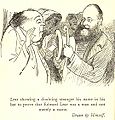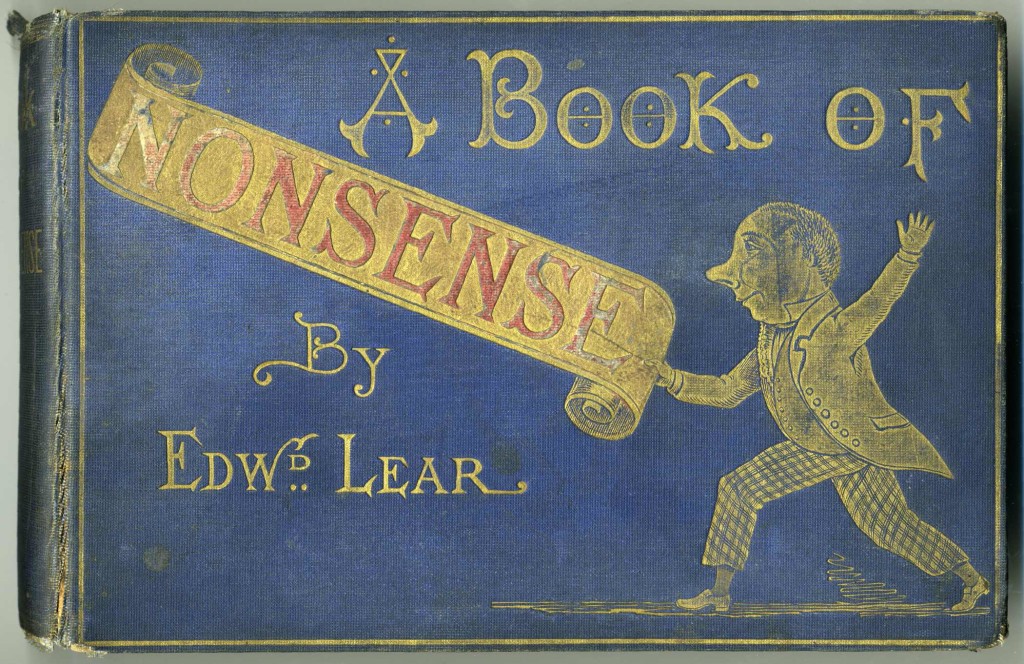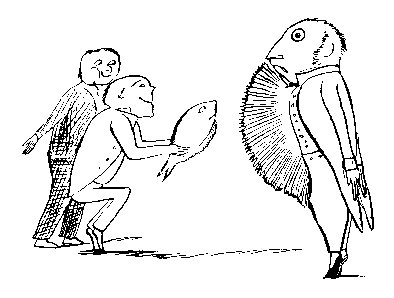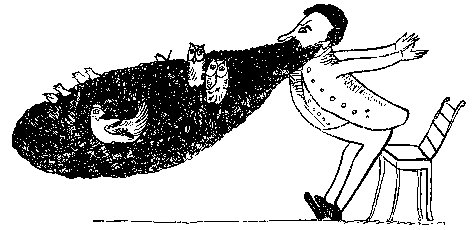Everyman's Library
Edward Lear was born in Holloway, Middlesex, England on this day in 1812."There Was An Old Person Of Nice"There was an old person of Nice,
Whose associates were usually Geese.
They walked out together, in all sorts of weather.
That affable person of Nice!*The owls, hen, larks, and their nests in his beard, are among the fey fauna and peculiar persons inhabiting the uniquely inspired nonsense rhymes and drawings of Lear (20th child of a London stockbroker), whose Book of Nonsense, first published in 1846, stands alone as the ultimate and most loved expression in English of freewheeling, benign, and unconstricted merriment.
British Museum
Edward Lear was born in Holloway, Middlesex, England on this day in 1812.
"There Was An Old Person Of Nice"
There was an old person of Nice,
Whose associates were usually Geese.
They walked out together, in all sorts of weather.
That affable person of Nice!
Whose associates were usually Geese.
They walked out together, in all sorts of weather.
That affable person of Nice!
*
The owls, hen, larks, and their nests in his beard, are among the fey fauna and peculiar persons inhabiting the uniquely inspired nonsense rhymes and drawings of Lear (20th child of a London stockbroker), whose Book of Nonsense, first published in 1846, stands alone as the ultimate and most loved expression in English of freewheeling, benign, and unconstricted merriment.
British Museum
Artist and author Edward Lear died #onthisday in 1888. Although he was a painter by profession, he is better known as the author of nonsense verse and limericks. Can you devise a limerick in his honour? http://ow.ly/I90ta
讀"愛德華.李爾:隱藏在自然史後的狂野面"《知識通訊評論》
(今年是 Edward Lear 200周年慶 上文登在科學雜誌 因他也是著名的鳥類插畫家 Edward Lear - Wikipedia, the free encyclopedia 與奧杜邦(John James Audubon)創作的《美國鳥類》(The Birds of America此書中國有翻譯)齊名。)
想起一段友情
2005年我介紹 Edward Lear 的諧趣詩 Edward Lear, Book of Nonsense 1-10
並贈『未晚齋』給文友瑞麟
他很有毅力 將該書以"每日一詩"方式翻譯出來
可惜的是。 瑞麟兄給我回信說 , 他已將BLOGs中英美文學部分都刪除了。
----2005 Simon University 一瞥
rl 留言(re: 李叔湘先生的『未晚齋』(文集)--
為了這篇作業不想作晚飯的rl ):「
吕叔湘:《未晚斋杂览》为32开本,全书不到百页,收录七篇文章:
霭理士论塔布及其它
赫胥黎和救世军
葛德文其人
李尔和他的谐趣诗
《第二梦》
《书太多了》
买书‧卖书‧搬书
其中的李尔和他的谐趣诗就是日前我每日一诗的诗人Edward Lear;校长所提的J.M. Barrie作品指的是Dear Brutus,则是在《第二梦》这篇文章里,我个人因为并未阅读过这部作品,所以对此无动于衷。文中大致介绍这是三幕剧剧本,剧名取自第三幕,剧中人引用莎翁的两行诗:
Casius The fault, dear Brutus, is not in our stars, But in ourselves, that we are underlings.
(以上英文无误地抄自该书,显然版面需要加以订正)
书中提到朱生豪的译文,并对朱译underlings作「受制于人」有意见。
文章取名《第二梦》是作者曾在协和医学院看过燕大毕业演出的一个话剧,剧名就叫《第二梦》,作者觉得情节与Dear Brutus十分相似,认为是译本或改编本。文章其余部分开始介绍第二梦的故事和一些对白。
文末始介绍J.M. Barrie一生写了38个剧本,其中以《可敬的克莱登》和《彼得潘》最有名。」
*****
由於讓RL晚餐誤點,準備介紹 Sir J.M. Barrie。發現電影之原作:
參考:
http://www.newyorker.com/critics/atlarge/?041122crat_atlarge
LOST BOYS
by ANTHONY LANE
Why J. M. Barrie created Peter Pan.
----
J.M. Barrie 的介紹和電子檔,英國和日文都很豐富。
我們可以從更寬的視野看Sir J.M. Barrie在英國/蘇格蘭/世界文化的主要業績,參考下書所特別介紹的這些作家(這本書hc還沒讀過):
Jackie Wullschlager, Inventing Wonderland: The Lives and Fantasies of Lewis Carroll,
Edward Lear, JM Barrie, Kenneth Grahame, and A A Milne, 1996. 日本翻譯:『不思議の国をつくる:キャロル、リア、バリー、グレアム、ミルンの作品と生涯』
「…..文末始介绍J.M. Barrie一生写了38个剧本,其中以《可敬的克莱登》和《彼得潘》最有名。」
這兩本/齣劇本的書名都成為英國(文)的常用名詞。
《可 敬的克莱登》就是The Admirable Crichton, J. M. Barrie在 1902的作品。(日本翻譯: 「天晴れクライトン」 (1902年初演)【天晴れ(あっぱれ) 意思: Bravo!/ Well done!・~な splendid; admirable; glorious.】 http://www.answers.com/topic/the-admirable-crichton-1?hl=crichton)
要了解The Admirable Crichton作為類型人物,先要了解劇情/歷史。
The Admirable Crichton指「無所不能、面面俱到/俱佳的人」。
Peter Pan 為長不大的小孩。這成為商標。1960年代,美國流行一種通俗心理學TA,說法是人人的人格中都還有一CHILD要照顧……
The Birth (and Death) of Edward Lear
May 12, 2014 | by Dan Piepenbring
You’d think it would be easy to invent nonsense words. After all, the real lexical bummer usually rests in the burden of definition: your average neologism has to mean something. Nonsense words, on the other hand, are not merely devoid of but entirely divorced from meaning—creating them should just be a matter of aesthetics. Throw a couple consonants together, make sure there’s a vowel in there someplace: voilà. And yet—
Hlerkjer—not a very good nonsense word.
Grimblurp—better, but still aesthetically lacking…
Runcible—now, that’s quality nonsense.
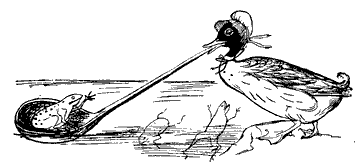 Runcible is a creation of Edward Lear’s, arguably his pièce de résistance—though it faces stiff competition from the likes oftilly-loo, Yonghy-Bonghy-Bò, tiniskoop,cheerious, meloobious, gromboolian,mumbian, bruffled, dolomphious, borascible,fizzgiggious, himmeltanious, tumble-dum-down, spongetaneous, and blatter-platter. Lear, born today in 1812, was a prolific painter and illustrator, but the poem—especially the limerick—is where he really left his mark. In such volumes as The Book of Nonsense;More Nonsense Songs, Pictures, Etc.; Nonsense Botany; The Quangle-Wangle’s Hat; andScroobious Pip, he cultivated an ear for twaddle, malarkey, and piffle that remains largely unrivaled in letters to this day. His nonsense words have a certain authority to them, so much so that one feels compelled to define them—and on the tongue they have an inimitable springiness, an Anglo-Saxon lilt. When Lear’s characters aren’t named after nonsense or spouting it, they tend to be pursuing it in some form or another, as they do here, in the first stanza of “The Jumblies”:
Runcible is a creation of Edward Lear’s, arguably his pièce de résistance—though it faces stiff competition from the likes oftilly-loo, Yonghy-Bonghy-Bò, tiniskoop,cheerious, meloobious, gromboolian,mumbian, bruffled, dolomphious, borascible,fizzgiggious, himmeltanious, tumble-dum-down, spongetaneous, and blatter-platter. Lear, born today in 1812, was a prolific painter and illustrator, but the poem—especially the limerick—is where he really left his mark. In such volumes as The Book of Nonsense;More Nonsense Songs, Pictures, Etc.; Nonsense Botany; The Quangle-Wangle’s Hat; andScroobious Pip, he cultivated an ear for twaddle, malarkey, and piffle that remains largely unrivaled in letters to this day. His nonsense words have a certain authority to them, so much so that one feels compelled to define them—and on the tongue they have an inimitable springiness, an Anglo-Saxon lilt. When Lear’s characters aren’t named after nonsense or spouting it, they tend to be pursuing it in some form or another, as they do here, in the first stanza of “The Jumblies”:They went to sea in a Sieve, they did,
In a Sieve they went to sea:
In spite of all their friends could say,
On a winter’s morn, on a stormy day,
In a Sieve they went to sea!
And when the Sieve turned round and round,
And everyone cried, “You’ll all be drowned!”
They cried aloud, “Our Sieve ain’t big,
But we don’t care a button, we don’t care a fig!
In a Sieve we’ll go to sea!”
Far and few, far and few,
Are the lands where the Jumblies live;
Their heads are green, and their hands are blue,
And they went to sea in a Sieve.
If Aesop had written his fables on a steady regimen of opiates, they might have turned out like Lear’s poems.
I came to Lear not through runcible—which remains, especially when paired with spoon, a vital part of the popular imagination—but by way of “The Death of Edward Lear,” a 1971 short story by Donald Barthelme in which Lear invites his friends and associates to join him at his deathbed. (He puts on quite a show, in one sense, and not much of a show at all, in another.) Barthelme, of course, was a purveyor of his own grade-A nonsense; you can read “The Death of Edward Lear” as a sort of winking memorial, even if it lacks for limericks. As is often the case with a Barthelme story, its humor begins to accrue a sense of sadness, an existential weight, as it goes on:
People who attended the death of Edward Lear agreed that, all in all, it had been a somewhat tedious performance. Why had he seen fit to read the same old verses, sing again the familiar songs, show the well-known pictures, run through his repertoire once more? Why invitations? Then something was understood: that Mr. Lear had been doing what he had always done and therefore, not doing anything extraordinary. Mr. Lear had transformed the extraordinary into its opposite. He had, in point of fact, created a gentle, genial misunderstanding.Thus the guests began, as time passed, to regard the affair in an historical light. They told their friends about it, reenacted parts of it for their children and grandchildren. They would reproduce the way the old man had piped "I've no money!" in a comical voice, and quote his odd remarks about marrying. The death of Edward Lear became so popular, as the time passed, that revivals were staged in every part of the country, with considerable success. The death of Edward Lear can still be seen, in the smaller cities, in versions enriched by learned interpretation, textual emendation, and changing fashion. One modification is curious; no one knows how it came about. The supporting company plays in the traditional way, but Lear himself appears shouting, shaking, vibrant with rage.

